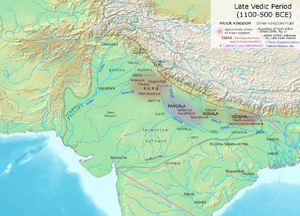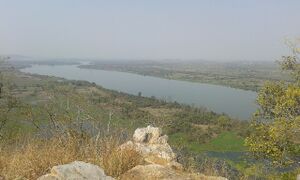Vidarbha

Vidarbha (विदर्भ) is the eastern region of Maharashtra, comprising Nagpur and Amravati Division. It occupies 31.6% of total area of Maharashtra (Population: 21.3% of the state).
Variants
- Barar बरार, दे. Vidarbha विदर्भ (AS,p.611)
- Berar बरार
- Vidarbha विदर्भ (AS, p.854)
- Varadatata वरदातट (AS, p.832)
Location
It borders Madhya Pradesh to the north, Chhatisgarh to the east, Telangana to the south and Marathwada and Khandesh regions of Maharashtra to the west.
Districts in Vidarbha
The names of districts in Vidarbha are:
1. Nagpur Division: Bhandara, Buldhana, Chandrapur, Garhchiroli, Gondiya, Nagpur, Wardha, Washim and Yavatmal.
2. Amravati Division: Akola, Amravati, Buldhana, Yavatmal, Washim
Rivers in Vidarbha
Wainganga is the largest river in Vidarbha; along with its major tributaries, the Wardha, Kanhan, and Painganga, its waters flow south into the Godavari River.
In the north, five small rivers—Khapra, Sipna, Gadga, Dolar and Purna River—are tributaries of Tapti river.
Geography

Vidarbha lies in Central India on the northern part of the Deccan Plateau. It borders the state of Madhya Pradesh to the north, Chhattisgarh to the east, Telangana to the south and Marathwada and Uttar Maharashtra regions of Maharashtra to the west. It lies in the rain shadow region of the Western Ghats and the terrain is largely flat. The Satpura Range lies to the north of Vidarbha region with Melghat in Amravati district forming part of the southern offshoot of the Satpura Range. Large basaltic rock formations exists throughout the region, part of the 66-million-year-old volcanic Deccan Traps. Bhandara and Gondia district are entirely occupied by metamorphic rock and alluvium, making their geology unique in Maharashtra. The Poorna River basin lies in Western Vidarbha and comprises Akola District, Amaravati and Buldhana districts. The region has extremely high innate soil and water salinity.
Jat clans
History of Vidarbha
Ancient History: Vidarbha was part of the Satavahana Empire (1st century BCE - 2nd century CE), as suggested by Satavahana coin finds in Pauni.[1]
Vidarbha was ruled by the Vakataka dynasty in the 3rd and 4th centuries CE. It consists of two branches – The Pravarapura Nandivardhana and Vatsagulma (now called as Washim) branches. The Pravarapura Nandivardhana branch ruled from different capitals like Pravarapura (Paunar) in Wardha district and Mansar and Nandivardhan (Nagardhan) in Nagpur district. This branch used to maintain matrimonial alliances with the Guptas.
The Vatsagulma branch was founded by Sarvasena, the second son of Pravarasena I after his death. Sarvasena made Vatsagulma (present-day Washim) his capital. The territory ruled by this branch was between the Sahydri Range and the Godavari River. They patronised some of the Buddhist caves at Ajanta. Prabhavatigupta was the queen and regent of the Vākāṭaka Empire. Her father was Chandragupta II of the Gupta Empire and her mother was Kuberanaga of the Naga. She married Rudrasena II of the Vākāṭaka. After his death in 385, she ruled as regent for her two young sons, Divakarasena and Damodarasena for twenty years. This region is named after the mythological Vidarbha Kingdom mentioned in the Mahabharata.
Nagpur was the capital of the Berar Subah, known as the Gulshan-e-Berar in the Medieval period, from the rule of the Khaljis to the Mughals, according to the Ain-i-Akbari and Alamgir Namah. In 1724, when Nizam-ul-Mulk Asaf Jah declared independence, the existence of Berar as a Mughal Subah came to an end. It became (though nominally) a part of Nizam state.[2]
Then the Bhonsle dynasty of Marathas who in the mid-eighteenth century created an independent princely state that covered much of east-central India. After their defeat in the Third Anglo-Maratha War in 1818, the Bhonsle dominions were reduced to the Nagpur division.
In 1853 the last Maharaja of Nagpur died without a male heir and subsequently Nagpur division was incorporated into mainstream British India. Nagpur division became a part of the British Raj's Central Provinces in 1861.

Modern period: Amravati division, formerly known as Berar division, was administered by the Nizam of Hyderabad until 1853. In that year, citing misgovernance by the Nizam, the British colonial administration took direct control over the province. Berar was added to the Central Provinces in 1903.
During India's independence struggle Nagpur hosted the sessions of Indian National Congress several times. Sevagram in Wardha was arguably the capital of nationalistic India during the Gandhian era.
After India's independence in 1947, Central Provinces and Berar became the Indian state of Madhya Pradesh.
In 1956 Vidarbha was transferred to Bombay state along with all other Marathi-speaking areas. In 1960 Bombay State was split along linguistic lines into the states of Maharashtra and Gujarat. Marathi-speaking Vidarbha became part of the state of Maharashtra.
Mythology
Vidarbha's culture developed distinctly from the rest of Maharashtra in a different fashion. Many scriptures mention Vidarbha as the location of:
- Rukmini-haran (the elopement of Rukmini with Krishna). Rukmini is described as the princess of the Vidarbha King Bhishmaka and when she came to Amravati to worship goddess Ambadevi, Lord Krishna eloped with her. Later Rukmini became one of the chief queens of Krishna.
- Kundinpur/Kaundinyapur/Kundinapuri, the mythological capital of Vidarbha as mentioned in Mahabharata.[3]
- The story of King Nala and Damayanti, also in the Mahabharata.
- Ramayana has the reference of Vidarbha as one on the Janapadas at that time. In Ramayana, Queen Indumai, mother of King Dasharatha and the paternal grandmother of Rama, Lakshmana, Bharat and Shatrughna, was the Princess of Vidarbha.
- Kalidasa's epic poem Meghaduta mentions Vidarbha as the place of banishment of the Yaksha Gandharva.
विदर्भ
विजयेन्द्र कुमार माथुर[4] ने लेख किया है .....विदर्भ (AS, p.854): विंध्याचल के दक्षिण में अवस्थित प्रदेश जिसकी स्थिति वर्तमान बरार के परिवर्ती क्षेत्र में मानी गई है। विदर्भ अतिप्राचीन समय से दक्षिण के जनपदों में प्रसिद्ध रहा है। वृहदारण्यकोपनिषत में विदर्भी-कौडिन्य नामक ॠषि का उल्लेख है जो विदर्भ के निवासी रहे होंगे। पौराणिक अनुश्रुति में कहा गया है कि किसी ॠषि के श्राप से इस देश में घास या दर्भ उगनी बंद हो गई थी [p.855]: जिसके कारण यह विदर्भ कहलाया। महाभारत में विदर्भ देश के राजा भीम का उल्लेख है जिसकी राजधानी कुण्डिनपुर में थी। इसकी पुत्री दमयंती निषध नरेश की महारानी थी। 'ततो विदर्भान् संप्राप्तं सायाह्ने सत्यविक्रमम्, ॠतुपर्णं जना राज्ञेभीमाय प्रत्यवेदयन्'--वनपर्व 73,1.
विदर्भ नरेश भोज की कन्या रुक्मिणी के हरण तथा कृष्ण के साथ उसके विवाह का वर्णन भी श्रीमद्भावगत में है। श्री कृष्ण रुक्मिणी की प्रणय याचाना के फलस्वरूप आनर्त देश से विदर्भ पहुँचे थे। आनर्तादेकरात्रेण विदर्भानगमध्दयै (श्रीमद्भागवत 10,53,6). महाभारत में भीष्मक को, जो रुक्मिणी का पिता था, विदर्भ देश का राजा कहा गया है। भोजकट में उसकी राजधानी थी। हरिवंश पुराण (विष्णुपर्व 60,32) में भी विदर्भ की राजधानी भोजकट में बतायी गयी है।
कालिदास के समय में विदर्भ का विस्तार नर्मदा के दक्षिण से लेकर (रघुवंश सर्ग 5 के वर्णन के अनुसार अज ने जिसकी राजधानी अयोध्या में थी। विदर्भराज भोज की बहिन इंदुमती के स्वयंवर में जाते समय नर्मदा को पार किया था) कृष्णा के उत्तरी तट तक था। रघुवंश 5,41 में अज का इंदुमती स्वयंवर के लिए विदर्भदेश की राजधानी जाने का उल्लेख है-- 'प्रस्थापयामास ससैन्यमेनमृध्दां विदर्भाधिपराजधानीम्।'
विदर्भ उत्तरी और दक्षिणी भागों में विभक्त था। उत्तरी विदर्भ की राजधानी अमरावती और दक्षिणी विदर्भ की प्रतिष्ठानपुर थी। मालविकाग्निमित्र, अकं 5 के निम्न वर्णन से सूचित होता है कि शुंग काल में विदर्भ-विषय नामक एक स्वतन्त्र राज्य था-- 'विदर्भविषयाद् भ्रात्रा वीरसेनेन प्रेषितं लेखं लेखकरैः वाच्यमानं श्रृणोति'। मालविकाग्निमित्र में विदर्भराज और विदिशा के शासक अग्निमित्र (पुष्पमित्र शुंग का पुत्र) का परस्पर वैमनस्य और युद्ध का वर्णन है। विष्णु पुराण 4,4, में विदर्भ तनया केशिनी का उल्लेख है जो सगर की पत्नी थीं।
मुग़ल सम्राट अकबर के समकालीन अबुल फज़ल ने आइना-ए-अकबरी में विदर्भ का नाम वरदातट लिखा है। संभवतः वरदा नदी (वर्धा) के निकट स्थित होने के कारण ही मुग़ल काल में विदर्भ का यह नाम प्रचलित हो गया था। बरार तथा बीदर नामों की व्युत्पत्ति भी विदर्भ से ही मानी जाती है।
वरदातट
विजयेन्द्र कुमार माथुर[5] ने लेख किया है .....वरदातट (AS, p.832): वरदातट विदर्भ अथवा वरदा नदी के तटवर्ती प्रदेश को कहा जाता था, जिसका उल्लेख अकबर के दरबारी विद्वान अबुल फ़ज़ल ने 'आइना-ए-अकबरी' में भी किया है। ऐसा जान पड़ता है कि वरदा या वर्धा नदी के कांठे में स्थित होने के कारण ही विदर्भ या बरार के प्रदेश को मुग़ल काल में 'वरदा' कहा जाने लगा था।
External Links
See also
References
- ↑ "Pauni : (Vidarbha) The latest site which contributed valuable numismatic evidence confirming, once and for all, ancient Vidarbha's early Satavahana affiliation is Pauni, in district Bhandara." in Sarma, Inguva Karthikeya (1980). Coinage of the Satavahana Empire. Agam. p. 38.
- ↑ Imperial Gazetteer of India, v. 7, p. 369
- ↑ Rukhmini Udana: The Flight to sri Krishna Reunion by Dr Hemant Bonde Patil Atlantic publishers & Distributors, India, ISBN 978-8126926886
- ↑ Aitihasik Sthanavali by Vijayendra Kumar Mathur, p.854
- ↑ Aitihasik Sthanavali by Vijayendra Kumar Mathur, p.832

